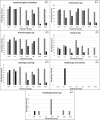Anthelmintic resistance in gastrointestinal nematodes of alpacas (Vicugna pacos) in Australia
- PMID: 29973276
- PMCID: PMC6031175
- DOI: 10.1186/s13071-018-2949-7
Anthelmintic resistance in gastrointestinal nematodes of alpacas (Vicugna pacos) in Australia
Abstract
Background: Gastrointestinal nematodes (GINs) can cause significant economic losses in alpacas due to lowered production of fibre and meat. Although no anthelmintics are registered for use in alpacas, various classes of anthelmintics are frequently used to control parasitic gastroenteritis in alpacas in Australia and other countries. Very little is known about the current worm control practices as well as the efficacy of anthelmintics used against common GINs of alpacas. This study aimed to assess the existing worm control practices used by Australian alpaca farmers and to quantify the efficacy of commonly used anthelmintics against GINs of alpacas.
Methods: An online questionnaire survey was conducted to assess current worm control practices on 97 Australian alpaca farms, with an emphasis on the use of anthelmintics. Of this group of 97 alpaca farms, 20 were selected to assess the efficacy of eight anthelmintics and/or their combinations (closantel, fenbendazole ivermectin, monepantel, moxidectin and a combination of levamisole, closantel, albendazole, abamectin) using the faecal egg count reduction test (FECRT). A multiplexed-tandem PCR (MT-PCR) was used to identify the prevalent nematode genera/species.
Results: The response rate for the questionnaire was 94% (91/97). Almost half of the respondents kept alpacas with sheep and cattle, and 26% of respondents allowed alpacas to co-graze with these ruminants. Although only 63% respondents perceived worms to be an important health concern for alpacas, the majority of respondents (89%) used anthelmintics to control GINs of alpacas. The commonly used anthelmintics were macrocyclic lactones, monepantel, benzimidazoles, levamisole, closantel and their combinations, and they were typically administered at the dose rate recommended for sheep. The FECRT results showed that a combination of levamisole, closantel, albendazole and abamectin was the most effective dewormer followed by single drugs, including monepantel, moxidectin, closantel, fenbendazole and ivermectin. Haemonchus spp. were the most commonly resistant nematodes followed by Trichostrongylus spp., Camelostrongylus mentulatus, Ostertagia ostertagi and Cooperia spp.
Conclusions: This is the first study aimed at assessing worm control practices and efficacy of commonly used anthelmintics in alpacas in Australia. Our findings document the extent of anthelmintics resistance on Australian alpaca farms and identify those anthelmintics that are still effective against GINs of alpacas.
Keywords: Alpacas; Anthelmintic; Australia; Nematodes; Resistance.
Conflict of interest statement
Ethics approval and consent to participate
The questionnaire survey was approved by the Human Ethics Committee (Ethics ID 1443529) of the University of Melbourne. The use of alpacas in this study was approved by the Animal Ethics Committee (AEC no. 1413412.1) of the University of Melbourne.
Consent for publication
Not applicable.
Competing interests
The authors declare that they have no competing interests.
Publisher’s Note
Springer Nature remains neutral with regard to jurisdictional claims in published maps and institutional affiliations.
Figures





Similar articles
-
An assessment of worm control practices used by alpaca farmers in Australia.Vet Parasitol. 2019 Jan;265:91-100. doi: 10.1016/j.vetpar.2018.12.006. Epub 2018 Dec 21. Vet Parasitol. 2019. PMID: 30638526
-
Multiplexed-tandem PCR (MT-PCR) assay to detect and differentiate gastrointestinal nematodes of alpacas.Parasit Vectors. 2018 Jun 28;11(1):370. doi: 10.1186/s13071-018-2963-9. Parasit Vectors. 2018. PMID: 29954433 Free PMC article.
-
Epidemiology of gastrointestinal nematodes of alpacas in Australia: I. A cross-sectional study.Parasitol Res. 2019 Mar;118(3):891-900. doi: 10.1007/s00436-019-06235-8. Epub 2019 Feb 4. Parasitol Res. 2019. PMID: 30719533
-
Preserving new anthelmintics: a simple method for estimating faecal egg count reduction test (FECRT) confidence limits when efficacy and/or nematode aggregation is high.Vet Parasitol. 2012 May 4;186(1-2):79-92. doi: 10.1016/j.vetpar.2011.11.049. Epub 2011 Nov 20. Vet Parasitol. 2012. PMID: 22154971 Review.
-
Systematic review of gastrointestinal nematodes of horses from Australia.Parasit Vectors. 2019 Apr 29;12(1):188. doi: 10.1186/s13071-019-3445-4. Parasit Vectors. 2019. PMID: 31036059 Free PMC article.
Cited by
-
Epidemiology of gastrointestinal nematodes of alpacas in Australia: II. A longitudinal study.Parasitol Res. 2019 Mar;118(3):901-911. doi: 10.1007/s00436-019-06236-7. Epub 2019 Feb 9. Parasitol Res. 2019. PMID: 30737673
-
Old world camels in Germany: parasitic nematode communities characterized by nemabiome analysis showed reduced anthelmintic efficacy according to the fecal egg count reduction test.Parasit Vectors. 2025 Jul 24;18(1):294. doi: 10.1186/s13071-025-06930-9. Parasit Vectors. 2025. PMID: 40708027 Free PMC article.
-
Anthelmintic resistance in small ruminants in the Nordic-Baltic region.Acta Vet Scand. 2021 Apr 27;63(1):18. doi: 10.1186/s13028-021-00583-1. Acta Vet Scand. 2021. PMID: 33906690 Free PMC article.
-
Simultaneous analysis of the of levamisole with triclabendazole in pharmaceuticals through developing TLC and HPLC-PDA chromatographic techniques and their greenness assessment using GAPI and AGREE methods.BMC Chem. 2023 Nov 24;17(1):163. doi: 10.1186/s13065-023-01087-x. BMC Chem. 2023. PMID: 37996961 Free PMC article.
-
Prevalence and molecular identification of gastrointestinal nematodes in Qinghai-Tibetan Plateau of China.Vet Med Sci. 2023 Nov;9(6):2693-2702. doi: 10.1002/vms3.674. Epub 2023 Oct 26. Vet Med Sci. 2023. PMID: 37882479 Free PMC article.
References
-
- Gerken M, Renieri C. South American camelids research. In: 4th European Symposium on South American Camelids and DECAMA European Seminar 2004, Göttingen, Germany. Wageningen: Wageningen Academic Publishers; 2006. p. 7–8.
MeSH terms
Substances
Grants and funding
LinkOut - more resources
Full Text Sources
Other Literature Sources
Miscellaneous

